Today, we’ll explore Mughal architecture in Delhi by visiting the Red Fort, Humayun’s Tomb, and Jama Masjid.
During my third year of university, I signed up for a course titled Islamic Art and Architecture for one of my electives. I was travelling in Argentina at the time my enrolment window opened, and I remember sitting in a hostel in Cordoba battling a slow internet connection while I tried to figure out what classes still had seats remaining.
There were a few different courses I was considering and not being the most assertive decision-maker, I turned to my friend Rebecca and asked her which one she thought I should go for. Being the art major and talented visual artist that she is, she suggested the art course.
I signed up.

That course ended up being one of my favourites of the year. It sparked my slight obsession with Central Asia (Uzbekistan is still a dream destination of mine!) and it also taught me to decipher the subtle meaning behind buildings which is often hidden in plain sight.
One period that we covered extensively in that course was that of the Mughals, an empire that ruled the Indian subcontinent from the early 16th century to the early 18th century and left a wealth of structures scattered across the land. Coming to Delhi, India those exquisite structures that I had once marvelled at on the pages of my textbook finally came to life.
Must-Visit Landmarks in Delhi: Red Fort, Humayun’s Tomb, and Jama Masjid
Red Fort
My first stop in Delhi was the Red Fort. We purposely booked a hotel within walking distance and on our first morning there Sam, his parents and I were out the door and on our way soon after sun-up.
The Red Fort was the main residence of the Mughals for almost 200 years and though it may be called a fort, this place is more like a walled city. After the Mughals moved their capital from Agra to Delhi, this became their primary residence and inside you can find a bazar, a mosque, various courts and pavilions, as well as imposing red sandstone gates that will make you feel tiny.
The whole place is beautiful, but the one structure that took my breath away was the Lahori Gate, named so because it faces towards Lahore, Pakistan. The gate is a giant mass of red sandstone, and the arch carries your eyes all the way up until you reach a roof pavilion, which I sadly couldn’t fit into one picture. Imagine setting foot through those gates several centuries back and finding yourself in the heart of a bustling bazaar!
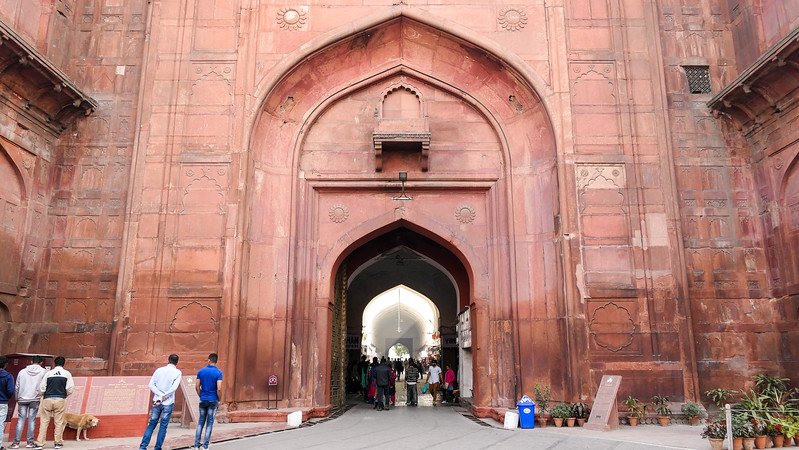
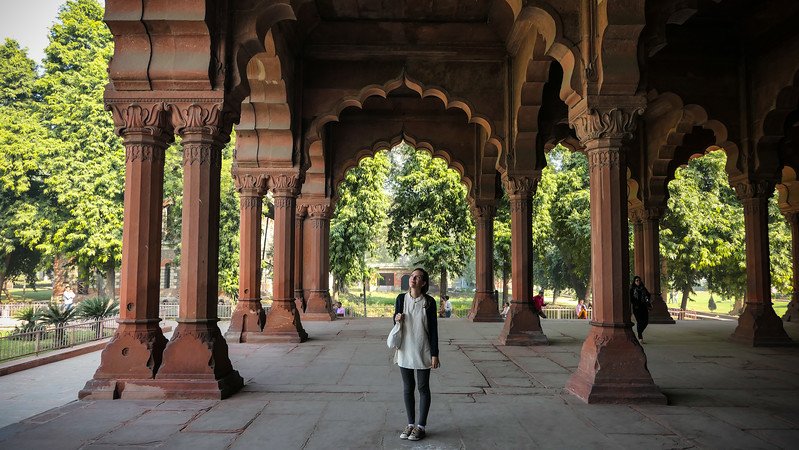
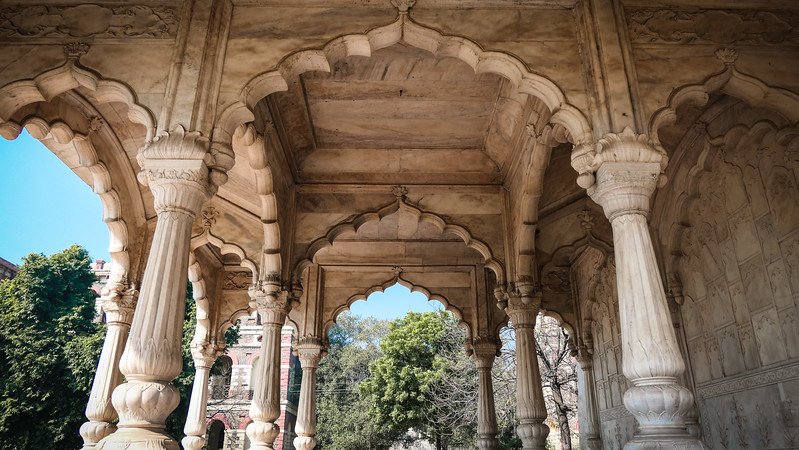
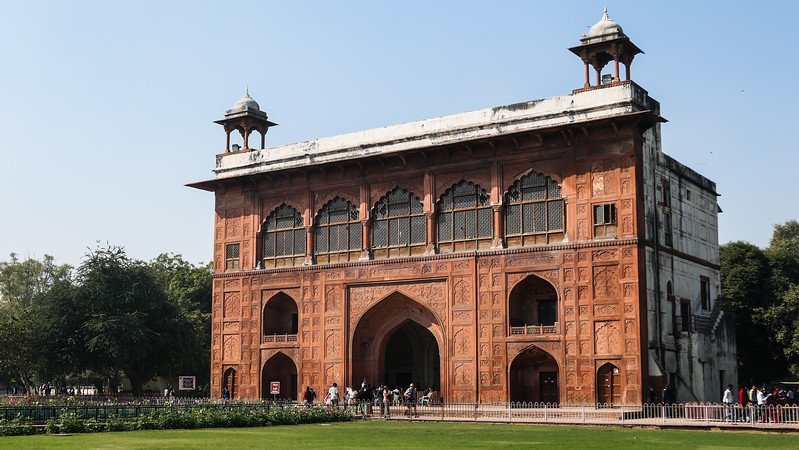
Humayun’s Tomb
Our second day in Delhi was reserved for the place I had been most looking forward to Humayun’s Tomb – a name that had been uttered in class at least a thousand times.
The tomb was commissioned by Humayun’s first wife, Empress Bega Begum, who deeply mourned his passing and consequently dedicated her life to building the most beautiful mausoleum to keep his memory alive. I think she did a pretty good job because, for me, this was the most beautiful building I saw in Delhi. When the sunlight hits the red sandstone it just glows, and then once you get up close and see all the intricate details on the facade, you can appreciate its beauty all over again.
Humayun’s Tomb was the first garden-tomb of its kind in India and it also provided the inspiration for the Taj Mahal which would be built many decades later, so if you’re heading to Agra this is a nice little sneak peek at what’s to come!



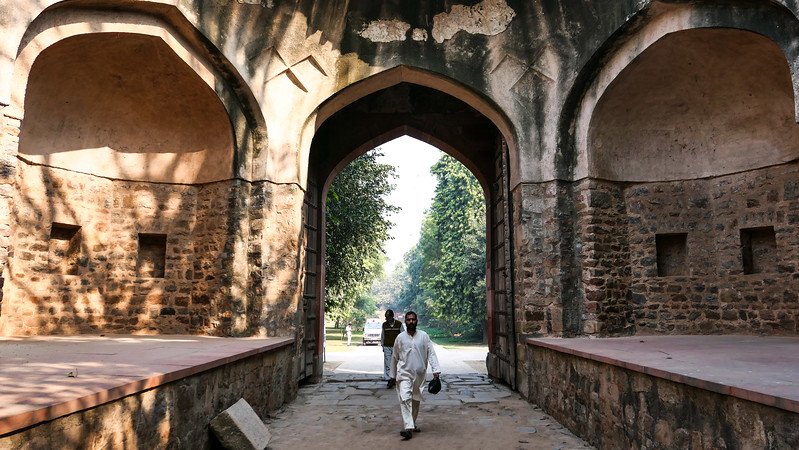
Jama Masjid
Lastly, on our third and final morning in Delhi, we went to Jama Masjid which is the largest mosque in India. We had attempted a visit the previous day, but we arrived just as they were closing for noon prayers, so we only got a quick glimpse of the exterior. Not this time!
After leaving our shoes at the door, we climbed the southern minaret for views of Old Delhi. While I’m not sure I would repeat the experience (it is a very narrow staircase with people competing to go up and down, plus once you reach the top there’s only a tiny platform to stand on – hello vertigo!), I did enjoy wandering the rest of the grounds.
Inside the prayer hall you’ll find white marble floors with black inlays that outline individual places for each prayer mat, the walls are decorated with sweeping arabesques, and you have an enormous crystal chandelier in the centre of the hall.
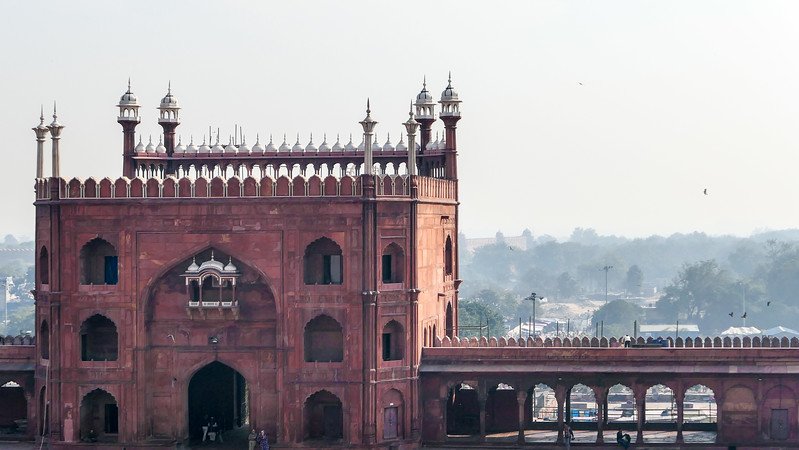
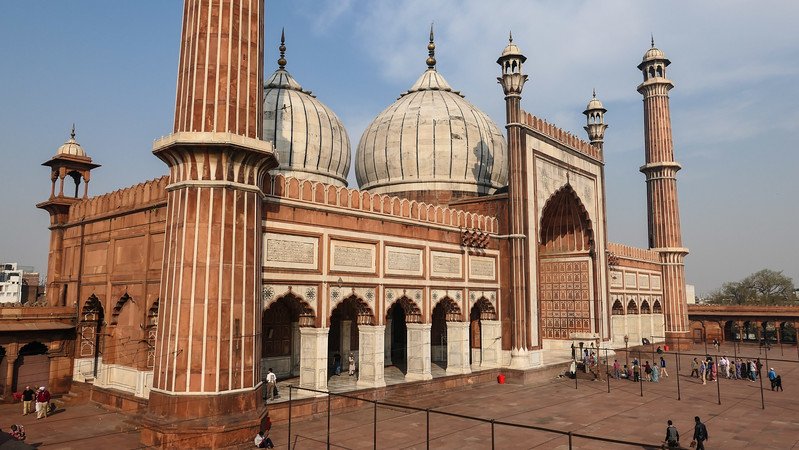
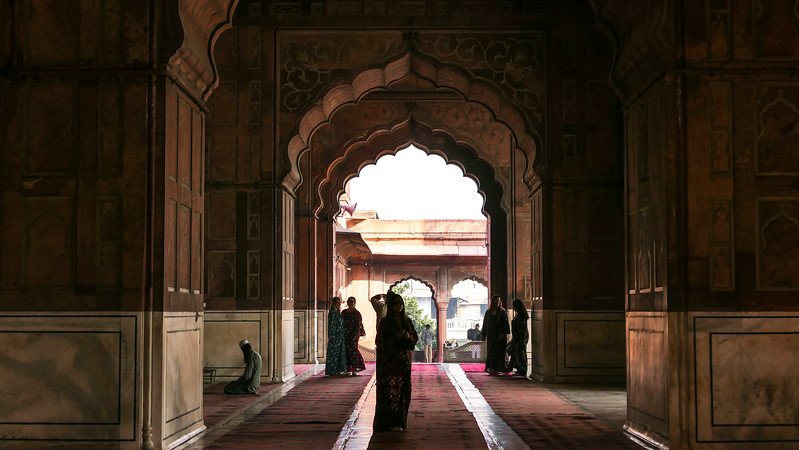
That was my grand introduction to Delhi: three days, three Mughal structures, and enough sandstone to leave me seeing red in the city.
As I write this I’m sitting in a homestay in Agra where the rooms are full of books and artefacts from around the world and you wouldn’t believe what I spotted. On a wooden coffee table with carved elephant figures lay the very same 600+ page title, Islam: Art and Architecture, which first introduced me to these buildings. I had to pick it up, flip through the pages, and laugh at the serendipity of it all.
Plan Your Own Mughal Delhi Day (Routes, Tips, Photo Ideas & Handy Checklists)
How to Order Your Day (or Three!)
You can absolutely see the “big three” in a single (ambitious) day, but if you love lingering, factor in two or three easy days. Mughal spaces reveal more the longer you let your eyes wander.
Option A: One Perfect Day (Sunrise to Sunset)
- Sunrise at Humayun’s Tomb
Arrive right as the gates open. The red sandstone glows, the gardens are quiet, and the symmetry is pure therapy. Bring water and breathe. - Late morning at Jama Masjid
Reach Old Delhi before lunch. Explore the courtyard and prayer hall, then amble through the lanes for a snack (details below). Avoid the noonday closure for prayers by checking posted times at the gate. - Late afternoon at the Red Fort
Let the heat mellow. The soft, angled light makes arches and jali screens sing. If you’re a museum person, allow extra time for the galleries inside the complex.
Why this order? You get the best light at Humayun’s Tomb, dodge the hottest hours in Old Delhi, and end with sprawling fort views as the day cools.
Option B: Two Gentle Days (My Favorite)
- Day 1: Humayun’s Tomb + nearby add-ons (Nizamuddin Basti lanes, Sunder Nursery gardens)
- Day 2: Jama Masjid + Old Delhi eats in the morning, Red Fort in the late afternoon
Option C: Three Days (For Slow Travelers & Architecture Nerds)
- Day 1: Humayun’s Tomb complex (explore the satellite tombs too), late lunch, bookshop browse
- Day 2: Jama Masjid + Old Delhi food crawl + heritage walk
- Day 3: Red Fort + museums, then a sunset rickshaw ride along the walls
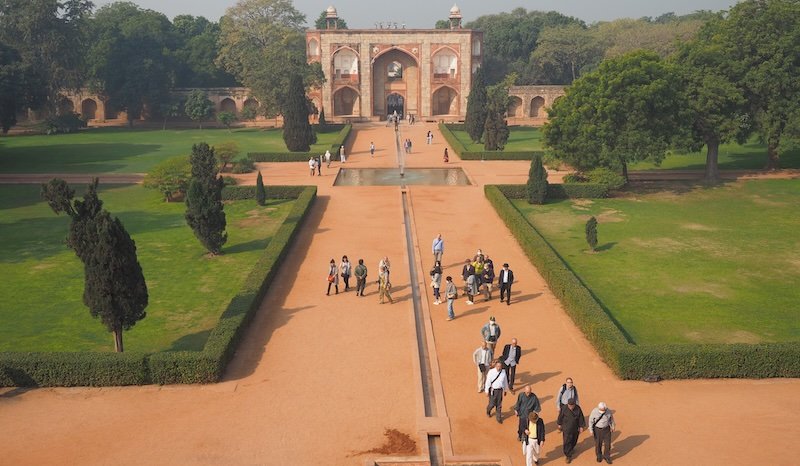
Reading the Buildings (A Friendly Field Guide)
The Big Three Signatures
- Symmetry & Axial Planning
Stand at center lines (doors, domes, garden paths). Notice how everything balances left–right and front–back. - Red Sandstone + White Marble
A cherished contrast: earthy warmth meets luminous cool. From afar it’s bold graphics; up close it’s delicate inlay. - The Charbagh (Four-Part Garden)
Especially at Humayun’s Tomb: water channels and paths divide the garden into four, nodding to paradise imagery.
Details to Spot (Make it a game!)
- Jali screens: Stone lacework casting patterned shadows (seek them in pavilions).
- Lotus & cypress motifs: Floral carvings that mingle Persian and Indian sensibilities.
- Calligraphy bands: Qur’anic verses in elegant scripts tracing portals.
- Cusped arches: Those soft scallops that feel almost like ripples in stone.
- Chhatris: The little domed kiosks punctuating rooflines (cuter than they sound).
- Pietra dura: Colored stone inlay forming flowers and vines on white marble panels.

Practicalities: Tickets, Timing, Dress & Getting Around
Opening Hours & Closures
- Humayun’s Tomb: Mornings are glorious; mid-days can be hot.
- Jama Masjid: The mosque remains open except during prayer times (especially midday) when visitors are asked to wait outside.
- Red Fort: Afternoons to sunset offer kinder light and smaller tour groups.
What to Wear
- Respectful clothing is appreciated everywhere; it’s required inside the mosque.
- Shoulders and knees covered.
- Carry a light scarf (handy for head covering at Jama Masjid).
- Slip-on shoes or sandals you can remove easily (you’ll leave shoes before entering the prayer hall; socks help when the ground is hot or chilly).
Bags & Security
- Expect standard security checks at fort and tomb entrances.
- Pack light: water, hat, sunscreen, a small power bank, and tissues/hand sanitizer.
Getting Around (Simple & Sane)
- Metro: Fast, reliable. Pair with short rickshaw rides.
- Auto-rickshaw: Perfect for the hops between sites; agree on fare or use the meter.
- Ride-hailing apps: Easy for longer rides or if you’re tired of negotiating.
Eat Nearby (Because Admiring Arches Builds an Appetite)
- Near Humayun’s Tomb:
- Sunder Nursery café for a calm, leafy brunch if you pair the gardens with your visit.
- Small bakeries and tea stalls in Nizamuddin Basti—go with curiosity and a smile.
- Old Delhi around Jama Masjid:
- Seekh kebabs, nihari, jalebi, kulfi in lanes just beyond the mosque (look for busy, well-established shops).
- Early mornings and evenings are the tastiest times; midday heat saps the joy.
- Red Fort side:
- Snack, then consider a sit-down meal away from the crowds (grab a taxi/auto to a favorite café in the newer parts of town).
Stomach-kind tip: Bottled or filtered water, freshly cooked foods, and clean, high-turnover spots are your friends.
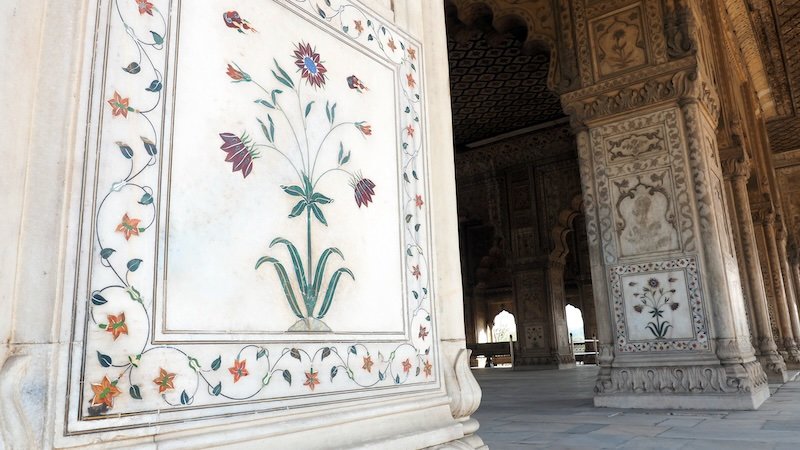
A Simple Comparison (Plan at a Glance)
| Feature | Red Fort | Humayun’s Tomb | Jama Masjid |
|---|---|---|---|
| Vibe | Walled city, pavilions, long axes | Serene garden-tomb, pure symmetry | Living mosque, vast courtyard |
| Time Needed | 2–3 hours (more with museums) | 1.5–2 hours (longer if exploring sub-tombs) | 45–90 minutes (plus area wander) |
| Best Light | Late afternoon to sunset | Sunrise to early morning | Morning or late afternoon |
| Don’t Miss | Arches & pavilions, jali, historic gateways | The long approach, marble inlay, garden vistas | Courtyard geometry, calligraphy, city views |
| Good For | History lovers, big-space wanderers | Symmetry seekers, photographers | Culture lovers, Old Delhi explorers |
Pack This (Mughal Day Checklist)
Absolute essentials
- ☐ Water (refillable bottle)
- ☐ Hat, sunscreen, sunglasses
- ☐ Light scarf (multipurpose: sun, dust, head covering)
- ☐ Comfortable, respectful clothing + easy-on/off shoes
- ☐ Tissues & hand sanitizer
- ☐ Small power bank + cable
- ☐ Cash for small purchases, tips, rickshaws
Nice to have
- ☐ Foldable fan or cooling towel (Delhi knows heat)
- ☐ Mini first-aid (band-aid, ibuprofen, rehydration salts)
- ☐ Notebook (you’ll want to jot motifs and impressions)
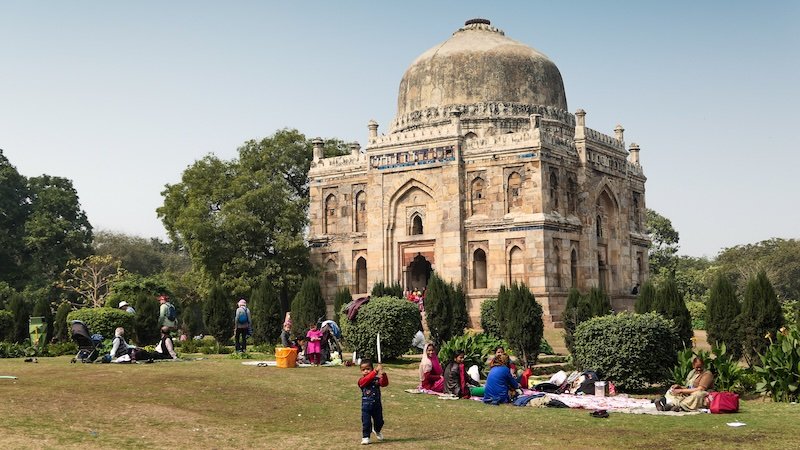
Common Mistakes (And How to Dodge Them)
- Racing the sites: Slow down. You’ll notice more (and enjoy more).
- Arriving at Jama Masjid during prayers: Check the posted times and plan a snack break nearby.
- Underestimating heat: Hydrate regularly and chase shade.
- Forgetting a scarf: It’s the single most useful square of fabric on the subcontinent.
- Shooting into harsh noon sun: Embrace mornings and late afternoons; your photos (and forehead) will thank you.
Mughal Architecture in Delhi: 12-Question FAQ for Visiting Red Fort, Humayun’s Tomb & Jama Masjid (routes, etiquette, photo tips)
1) What’s the best order to visit Red Fort, Humayun’s Tomb, and Jama Masjid in one day?
Do sunrise at Humayun’s Tomb (soft light, quieter gardens), late morning at Jama Masjid (avoid prayer closures), and golden hour at the Red Fort (dramatic sandstone glow). If you have two days, pair Humayun’s Tomb with Sunder Nursery/Nizamuddin Basti, and save Old Delhi (Jama Masjid + food lanes) and the Red Fort for day two.
2) How do I reach each site easily?
Use the Delhi Metro + short auto-rickshaw hops. Ride-hail works well between clusters (e.g., Nizamuddin ↔ Old Delhi). Traffic thins early morning and after sunset; mid-day can be slow around Chandni Chowk and Daryaganj.
3) What should I wear—and are there extra rules for Jama Masjid?
Dress modestly at all three; at Jama Masjid shoulders and knees must be covered (carry a light scarf for head/shoulders if requested). You’ll remove shoes before entering the prayer hall—socks help with hot/cool floors. Drone use is not allowed; follow on-site security instructions.
4) Can I photograph freely?
Outdoors, yes—be mindful of restricted areas, security checkpoints, and prayer spaces. At Jama Masjid, avoid photographing worshippers up close without permission. Early or late light flatters red sandstone and marble; mid-day contrast is harsh.
5) What architectural features should I look for?
Make a scavenger list: charbagh garden plan (Humayun’s), jali stone screens, calligraphic bands, cusped arches, chhatris (domed kiosks), and pietra dura floral inlay on marble. Stand on axial centerlines to appreciate Mughal symmetry.
6) How much time should I budget at each site?
Humayun’s Tomb: 90–120 min (include Isa Khan’s & other sub-tombs).
Jama Masjid: 45–90 min (plus lane wandering outside).
Red Fort: 2–3 hours (more if you visit the museums). Add buffer for security queues.
7) Any timing gotchas or closures?
Jama Masjid pauses tourist entry during prayer times (especially mid-day). All sites are busiest late morning to mid-afternoon; plan sunrise or late-afternoon visits for fewer crowds, cooler temps, and better photos. Always check on-site notices for special events.
8) Are guided tours worth it?
A good guide brings inscriptions, dynastic context, and urban history to life—especially inside the Red Fort pavilions and around Old Delhi’s lanes. If self-guided, read the plaques and carry a short primer on Mughal symbolism to decode motifs.
9) What about tickets and payments?
Most ticket windows accept card and/or digital payment, but carrying small cash helps for lockers, shoe-keeping, tips, and autos. Keep your tickets—you may be asked again inside multi-gate complexes.
10) Family & accessibility tips?
Humayun’s gardens are stroller-friendly with shade; some tomb and pavilion thresholds have steps. The Red Fort spans long distances—bring water and sun hats. At Jama Masjid, expect stairways and shoe removal; consider socks or disposable foot covers.
11) Where (and what) should I eat nearby?
Pair Jama Masjid with Old Delhi staples: seekh kebabs, nihari, jalebi, kulfi (choose busy, clean, high-turnover shops). Near Humayun’s, head to Sunder Nursery café or Nizamuddin Basti bakeries. Hydrate with bottled/filtered water; pick fresh-cooked meals.
12) What should be in my Mughal-day kit?
Refillable water bottle, hat/sunscreen, light scarf, comfortable modest clothing, easy on/off shoes, tissues/hand sanitizer, small power bank, and a short list of must-spot details (jali, chhatris, calligraphy) to make the architecture “click”.
Mini-Glossary
- Charbagh: Four-part garden plan.
- Chhatri: Small domed pavilion/kiosk (adorable rooftop punctuation).
- Jali: Ornamental perforated stone screen.
- Pietra dura: Stone inlay decoration in marble.
- Iwan: Vaulted hall or portal with an arched opening.
- Mihrab/Minbar: Niche indicating direction of prayer / pulpit in a mosque.
Have you checked out the Mughal architecture in Delhi?
Check out our Delhi City Guide Travel Video below!

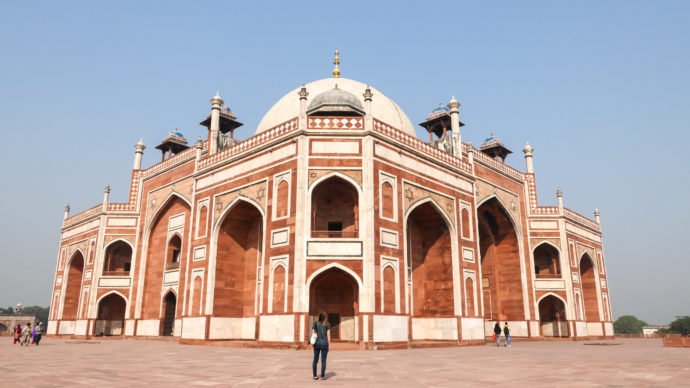
These pictures are gorgeous! I had never heard of Humayun’s Tomb. I would probably visit this site before the Taj Mahal after seeing these photos. What strikes me (which you probably covered in your art history class) is the scallops in the architecture. They are really unique. Other architects are praised around the world for their clean lines or large domes. The scallops are such a rare example of this kind of attention to detail. Just beautiful!
I hope you get to visit, Leah! It’s amazing to see the amount of detail that went into these buildings, especially once you get up close.
Delhi looks beautiful though! And I really love their architecture!
-Kiara
http://www.viaisabelle.com
There are some real gems scattered across the city. There were so many other temples and tombs that I wanted to visit, but I ran out of time!
Lovely photos! While I openly admit that Delhi is not my favorite city in India, it is certainly picturesque. Thank you for capturing its beauty and for reminding me of the good memories I have of the city. I hope you enjoy the rest of your travels in India! 🙂
Thanks Veena! I ended up enjoying Delhi a lot more than I thought I would. Some parts were overwhelming – especially around Old Delhi – but it was these little pockets of tranquility that made all the difference.
Wow, as an art lover and history addicted I am sure I would love these sights. I think Islamic architecture deserves more attention: it is really amazing.
Agreed! You could turn a trip to India into an architecture themed tour. There are so many amazing structures scattered across the country.
It looks amazing and I love the sound of the class you took – a good way to have a taste of travel while studying! Do you still plan to make a video about earning money as a digital nomad? You mentioned it in January and I’ve been on the edge of my seat ever since! Thanks for all the great videos and blog posts – I am saving up all your tips as I save up for my trip : ) Hope you have a great time in India. Try Idli Samba while you are there if you can. (It’s a dish from South India and it’s amazing!)
Hi Frey! Yes, we’re planning to make that video now that we’re back in Canada for a bit. We’re currently editing Nepal and India, so that one’s next on the list. In the meantime I’ll say that when I first started out, I was doing a lot of freelance writing for various travel websites, but these days I’ve been doing more to monetize my blog and YouTube.